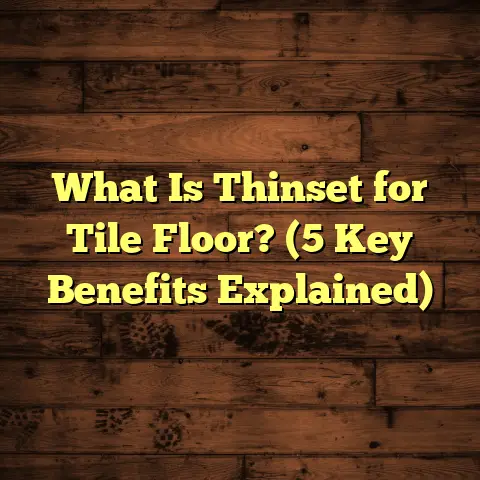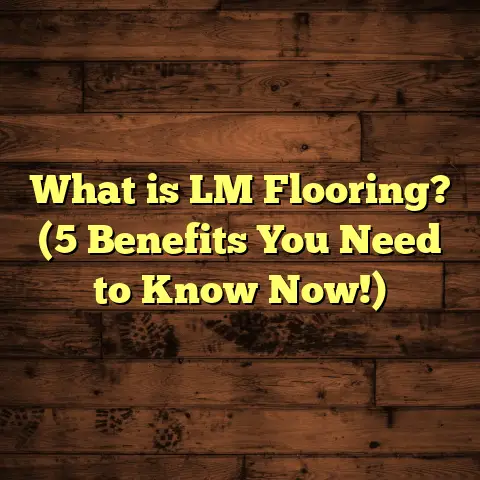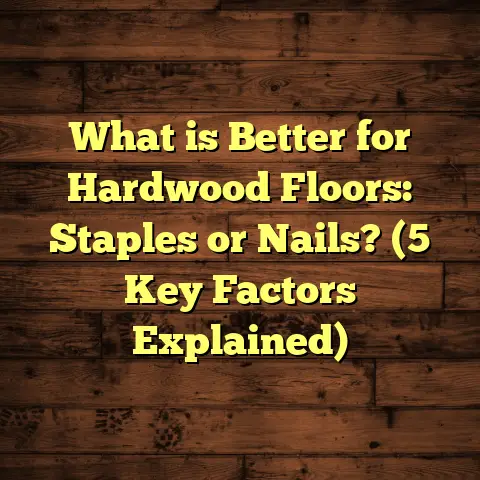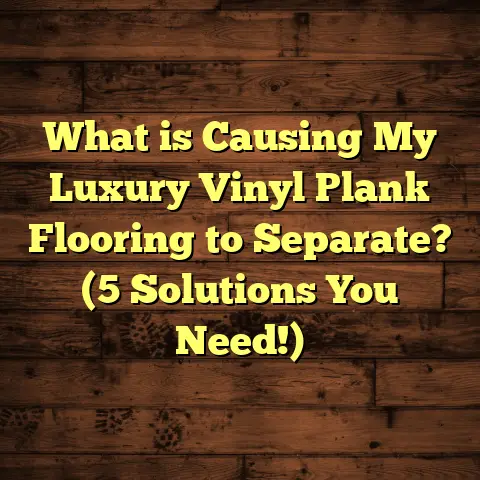What is an Epoxy Floor? (5 Amazing Benefits You Need to Know)
Have you ever stepped into a space and immediately thought, “Wow, this floor looks incredible!”? I have, many times. And more often than not, that feeling comes from the magic of epoxy flooring. But what exactly is an epoxy floor? Why is it so popular across garages, hospitals, factories, and even trendy cafés? Why does it keep popping up in so many places? If you’re curious about these questions—or if you’ve been considering flooring options for your own space—stick with me. I’ll walk you through everything you need to know about epoxy floors.
Let me share what I know from years of hands-on work with epoxy floors, blending technical details with real-world experiences. You’ll get the facts, useful insights, and some stories from the field too. By the end, you’ll see why epoxy flooring might be the perfect fit for your next project.
What Is an Epoxy Floor?
At its simplest, an epoxy floor is a coating made from a mixture of resins and hardeners that chemically react to form a tough plastic material. This plastic bonds tightly to concrete surfaces, creating a smooth, durable finish that can be glossy or matte depending on the formulation.
But there’s more to it than just mixing some chemicals and slapping it on the ground. Epoxy flooring is a complex system designed to protect floors and add beauty—making them resistant to wear, stains, moisture, and chemicals.
The Science Behind Epoxy
Epoxy is a type of thermosetting polymer. When the epoxy resin and hardener combine, they undergo a curing reaction that transforms the liquid mixture into a solid plastic layer. This reaction is exothermic (it releases heat) and creates cross-linked molecules that give epoxy its strength.
This cured epoxy forms a seamless surface that adheres extremely well to concrete or other substrates. The bonds formed are chemical as well as mechanical, which is why epoxy floors last so long.
From a technical perspective, epoxy coatings fall into several categories based on their formulation:
- 100% Solids Epoxy: Contains no solvents or water; cures very hard and durable.
- Solvent-based Epoxy: Includes solvents to make application easier but emits fumes.
- Water-based Epoxy: Lower VOCs (volatile organic compounds), safer for indoor use but usually less durable than 100% solids.
- Novolac Epoxy: Highly chemical resistant; used in industrial environments.
When I first started applying epoxy floors on industrial sites, I was amazed by how different formulations reacted under varying conditions. For example, 100% solids epoxy worked wonderfully in heavy load areas but required careful ventilation during installation due to fumes.
How Epoxy Floors Are Installed
Installation involves multiple layers:
- Surface Preparation: This is critical. Concrete must be clean, dry, and free of cracks or contaminants like oil or grease. Often this means grinding or shot blasting the surface to open up pores for better adhesion.
- Primer Coat: Helps the epoxy bond firmly to the concrete and seals pores.
- Base Coat: The main epoxy layer that provides durability and color.
- Top Coat: A protective layer that adds shine and guards against scratches and UV damage.
Skipping or rushing any of these steps can lead to poor adhesion or premature failure.
On one job site—a busy commercial kitchen—I saw firsthand how inadequate surface prep caused the epoxy to peel off after just a few months. After redoing the prep properly and reapplying epoxy, the floor lasted for years without issue.
5 Amazing Benefits of Epoxy Floors You Should Know
Let’s dig into why so many people swear by epoxy floors. I’m sharing benefits that come straight from my experience combined with industry data.
1. Durability That Goes Beyond Expectations
If you want a floor that lasts decades without cracking or chipping, epoxy is your go-to solution. It’s incredibly tough—resistant to impacts, abrasions, and heavy loads.
Concrete alone can crack or chip under pressure, but with an epoxy layer, it becomes far more resilient. According to industry research, epoxy floors can boost concrete lifespan by up to 10 years or more when properly maintained.
In warehouses where forklifts operate daily or in automotive repair shops exposed to heavy tools and oil spills, epoxy floors hold up remarkably well. One warehouse client of mine reported zero floor damage even after 12 years of constant forklift traffic.
Additionally, epoxy floors resist wear better than many other coatings—vinyl or paint included—making them ideal for high-traffic commercial or industrial environments.
2. Cleaning Made So Much Easier
Cleaning’s a chore we all dread—but with an epoxy floor? It becomes almost fun! Or at least way less annoying.
The seamless surface means no grout lines or cracks where dirt and grime can hide. A quick sweep or mop keeps it spotless.
I once worked with a daycare center that installed epoxy flooring in play areas. The staff loved how quickly they could clean up spilled juice or paint without staining or leaving sticky residues behind.
Epoxy also resists stains from oil, chemicals, and other spills better than most other floor types. This reduces the need for harsh cleaning chemicals that can damage floors over time.
3. Endless Style Options for Every Taste
When most people think “industrial,” they picture dull gray concrete. But epoxy floors shatter that stereotype entirely.
You can customize colors, textures, and finishes—matte, satin, or high-gloss—to suit any design style. Plus decorative chips or metallic pigments add dimension and flair.
I helped a trendy café create an epoxy floor with an ocean wave pattern using blue metallic flakes mixed into translucent resin. It wasn’t just functional; it became part of their brand story and drew customers in.
Or take another client who wanted a simple but elegant solid color for their home basement gym—they picked a deep charcoal gray with a matte finish that hid dirt well yet looked sleek.
Epoxy’s versatility means you don’t have to sacrifice aesthetics for durability.
4. Waterproof & Chemical Resistant Barrier
One of the most practical benefits I’ve seen clients appreciate is how epoxy flooring acts as a waterproof sealant over concrete.
Concrete is porous and absorbs water easily—leading to mold or structural damage over time if untreated. Epoxy locks out moisture completely.
In humid basements or garages where water tends to collect during rainy seasons, this means less worry about dampness or mold growth.
Furthermore, epoxy resists many chemicals including acids, alkalis, oils, gasoline, and solvents. This makes it perfect for industrial settings like factories or labs where spills are common.
A case study I reviewed involving a chemical plant showed epoxy floors reduced maintenance costs related to chemical damage by 70% compared to untreated concrete areas.
5. Cost-Effective Investment Over Time
At first glance, epoxy flooring may seem pricier than vinyl tiles or paint coatings. Installation costs typically range from $3 to $12 per square foot depending on quality and complexity of design.
However, when you consider durability and low maintenance needs over years, it often proves more economical overall.
For example: vinyl tiles might cost less initially but need replacement every 5–7 years due to wear or damage. Epoxy floors last much longer without repairs—saving money in the long run.
When estimating costs for my projects, I rely heavily on FloorTally—a tool that calculates local material prices, labor rates, and waste factors accurately so I can budget smarter. It saves me from both underestimating costs (which leads to delays) and over-ordering materials (which wastes money).
If you’re budgeting your flooring project yourself, tools like this are invaluable for realistic planning.
What Makes Epoxy Flooring Stand Out Compared to Other Flooring Types?
Let’s compare epoxy floors with some popular alternatives:
| Flooring Type | Durability | Maintenance | Cost (per sq ft) | Aesthetics | Best Use Cases |
|---|---|---|---|---|---|
| Epoxy | Very High | Low | $3 – $12 | Highly customizable | Industrial, garages, gyms |
| Vinyl Tiles | Medium | Medium | $2 – $7 | Good variety | Residential kitchens |
| Hardwood | Medium-High | Medium-High | $5 – $15 | Classic & warm | Living rooms & bedrooms |
| Laminate | Medium | Medium | $2 – $8 | Many styles | Budget-friendly homes |
| Ceramic Tile | High | Medium | $5 – $10 | Wide design range | Bathrooms & kitchens |
| Carpet | Low | High | $3 – $7 | Cozy & soft | Bedrooms & living rooms |
Epoxy stands apart for its unmatched combination of durability and maintenance ease—qualities hard to find together in other options.
My Personal Stories With Epoxy Floors
I’ve installed dozens of epoxy floors over the years—from industrial warehouses to residential basements—and each project offers unique lessons.
Story 1: The Auto Shop Transformation
A local auto repair shop approached me wanting a cleanable floor that could withstand oil spills and heavy machinery. Traditional concrete was stained and cracked after years of use.
We prepped the floor by grinding down old paint and grease spots thoroughly—this took a full day but was critical. Then applied a high-performance 100% solids epoxy coating in dark gray with anti-slip additives.
The owner called me after six months saying he couldn’t believe how easy cleanup was now and how customers complimented the professional look. Plus no new cracks appeared despite daily heavy use.
Story 2: Basement Playroom Makeover
One family wanted an easy-to-clean playroom floor safe for kids with allergies. They chose a low-VOC water-based epoxy in a cheerful light blue color with matte finish.
The curing time was longer due to cooler basement temperatures but worth waiting for such a smooth finish. The kids loved playing on it and parents appreciated how spills wiped right off without staining.
Story 3: Art Gallery Floor That Sparkled
A gallery owner wanted something unique for their showroom floor—a metallic epoxy with swirling silver patterns that reflected gallery lighting beautifully.
It was challenging applying multiple layers with precision but seeing visitors admire the floor made it worthwhile. This project showcased how epoxy isn’t just industrial—it can be art too.
What You Should Know Before Installing Epoxy Flooring
Surface Preparation Is Everything
Concrete needs to be clean, dry, and structurally sound before applying epoxy. Any moisture trapped beneath can cause bubbling or peeling later on.
If your slab has cracks or holes—get those repaired first with patching compounds designed for concrete floors.
I’ve seen projects fail because contractors rushed prep steps trying to save time; never cut corners here!
Timing & Curing Considerations
Epoxy usually takes 24-72 hours to become walkable; full cure can take up to a week depending on temperature/humidity conditions.
Lower temperatures slow curing significantly; higher temps speed it up but can cause bubbling if applied too thickly.
Good ventilation during application helps reduce fumes (especially with solvent-based epoxies).
Safety Precautions
Wear protective gear like gloves and masks when handling uncured epoxy—it contains chemicals that irritate skin/eyes.
Make sure pets/kids stay away during application until fully cured to avoid exposure risks.
Slip Resistance
Epoxy’s smooth finish can be slippery when wet unless you add anti-slip additives like sand or aluminum oxide granules during installation.
This is especially important in commercial kitchens or garages where liquids are common.
Interesting Data Points About Epoxy Floors
- Shore D Hardness: Typical cured epoxy achieves ratings around 80–90 on this scale—meaning it resists dents and scratches very well.
- Chemical Resistance: Laboratory tests show epoxies resist common acids (like sulfuric acid), alkalis (like sodium hydroxide), oils, gasoline without degrading for months.
- Slip Resistance Improvements: Adding anti-slip additives reduces slip accidents by nearly 50% in workplaces.
- Longevity: Many commercial installations last 10–20 years with minimal maintenance if properly installed.
- Return on Investment: Facilities switching from paint/coatings report up to 25% reduction in maintenance costs annually after installing epoxy floors.
Common Questions People Ask Me About Epoxy Flooring
Q: Can I install epoxy flooring myself?
A: If you have experience with painting/coatings and access to proper tools (grinder, respirators), DIY is possible but challenging—especially surface prep is key. Otherwise hiring professionals ensures better results.
Q: How long does an epoxy floor last?
A: Typically 10–20 years depending on traffic levels and maintenance habits.
Q: Is epoxy flooring slippery?
A: Untreated epoxy can be slick when wet; adding texture granules during installation helps prevent slips.
Q: How much does it cost?
A: Usually between $3-$12 per square foot depending on material quality and design complexity.
Q: Does epoxy yellow over time?
A: Some epoxies may yellow slightly under UV exposure; UV-resistant topcoats reduce this effect outdoors/in sunlit areas.
How Tools Like FloorTally Help Me Manage Projects
Budgeting flooring projects can be tricky—material prices vary by region; labor rates fluctuate; plus waste factors must be accounted for accurately.
I use FloorTally because it consolidates all these variables into one user-friendly platform that gives me precise estimates quickly. It accounts for local rates so my bids are realistic—not under or overpriced—which helps win jobs while maintaining margins.
Plus its waste factor calculator prevents ordering excess materials that would otherwise go unused—saving my clients money and reducing environmental impact.
Using such tools lets me focus more on quality installation rather than juggling spreadsheets manually.
Final Thoughts From My Experience
Epoxy flooring is one of those rare products that combine beauty with strength effortlessly. It offers unmatched durability for industrial uses while allowing stunning design possibilities for commercial or residential spaces alike.
Over the years I’ve seen how proper installation transforms dull concrete into floors people genuinely enjoy walking on every day—whether in garages filled with cars or gleaming art galleries welcoming visitors under perfect lighting.
If you want flooring that stands up to wear & tear without constant upkeep—and looks great doing it—epoxy deserves serious consideration based on what I’ve learned firsthand.
What do you think? Have you ever tried epoxy floors or considered them? Feel free to ask me anything—I’m happy to share more tips from my experience!





